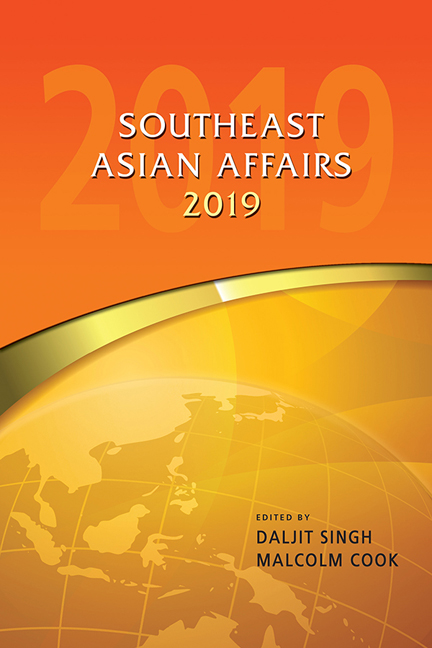Book contents
- Frontmatter
- Contents
- Introduction
- THE REGION
- Challenges to Southeast Asian Regionalism in 2018
- Regional Integration in Asia and the Pacific, and Dealing with Short and Long Term Challenges
- Looking West, Acting East: India's Indo-Pacific Strategy
- An Australian Vision of the Indo-Pacific and What It Means for Southeast Asia
- The Trump Administration's Free and Open Indo-Pacific Approach
- Japan's “Free and Open Indo-Pacific Strategy” and Its Implication for ASEAN
- BRUNEI DARUSSALAM
- CAMBODIA
- INDONESIA
- LAOS
- MALAYSIA
- MYANMAR
- THE PHILIPPINES
- SINGAPORE
- THAILAND
- TIMOR-LESTE
- VIETNAM
Japan's “Free and Open Indo-Pacific Strategy” and Its Implication for ASEAN
from THE REGION
Published online by Cambridge University Press: 07 September 2019
- Frontmatter
- Contents
- Introduction
- THE REGION
- Challenges to Southeast Asian Regionalism in 2018
- Regional Integration in Asia and the Pacific, and Dealing with Short and Long Term Challenges
- Looking West, Acting East: India's Indo-Pacific Strategy
- An Australian Vision of the Indo-Pacific and What It Means for Southeast Asia
- The Trump Administration's Free and Open Indo-Pacific Approach
- Japan's “Free and Open Indo-Pacific Strategy” and Its Implication for ASEAN
- BRUNEI DARUSSALAM
- CAMBODIA
- INDONESIA
- LAOS
- MALAYSIA
- MYANMAR
- THE PHILIPPINES
- SINGAPORE
- THAILAND
- TIMOR-LESTE
- VIETNAM
Summary
In August 2016, Japanese Prime Minister Shinzo Abe announced the “Free and Open Indo-Pacific Strategy” (FOIPs) at the Tokyo International Conference on African Development (TICAD) held in Kenya. Since then, many researchers, journalists and policymakers have discussed what the FOIP Strategy, and the broader concept of a Free and Open Indo-Pacific (FOIP), exactly means.
For some, FOIPs is essentially an exclusive concept that views China as “a hostile existential threat to regional (and global) order, prosperity, and Western interests”. Such a view tends to see Abe's FOIPs primarily as a geopolitical strategy aimed at countering Chinese power and influence by creating a maritime coalition with regional democracies, represented by the Quadrilateral Security Cooperation (Quad) between Japan, Australia, India and the United States. The FOIPs is also commonly seen as a competitor or “geoeconomic” strategy against China's Belt and Road Initiative (BRI) by providing the region with alternatives to BRI projects.
For others, however, FOIPs is an inclusive concept that ultimately aims to incorporate China and other powers in an inclusive political and economic system in the Indo-Pacific. Such a view, often stressed by the Japanese government and its officials, tends to dismiss the geopolitical aspect of FOIPs and argues that FOIPs is a comprehensive framework or “vision” for Japanese regional policies, mostly its economic and development cooperation such as infrastructure development and support for regional connectivity. This kind of view also stresses the cooperative, as well as the competitive, aspects of FOIPs by pointing out many overlaps or mutual complementarities, especially in the “third party cooperation”, between FOIPs and BRI. According to this line of argument, understanding FOIPs simply as a “counter-China strategy” is a stunted and short-sighted view which ignores the fact that the concept was developed as a response to the long-term shift in the centre of gravity of the global economy from Western Europe to the Pacific and Indian Oceans.
As such, there are almost opposite views over what FOIPs means. Which view explains the reality of FOIPs more accurately? With this question in mind, the chapter first examines why FOIPs has become an important strategic concept for Japan.
- Type
- Chapter
- Information
- Southeast Asian Affairs 2019 , pp. 69 - 82Publisher: ISEAS–Yusof Ishak InstitutePrint publication year: 2019



